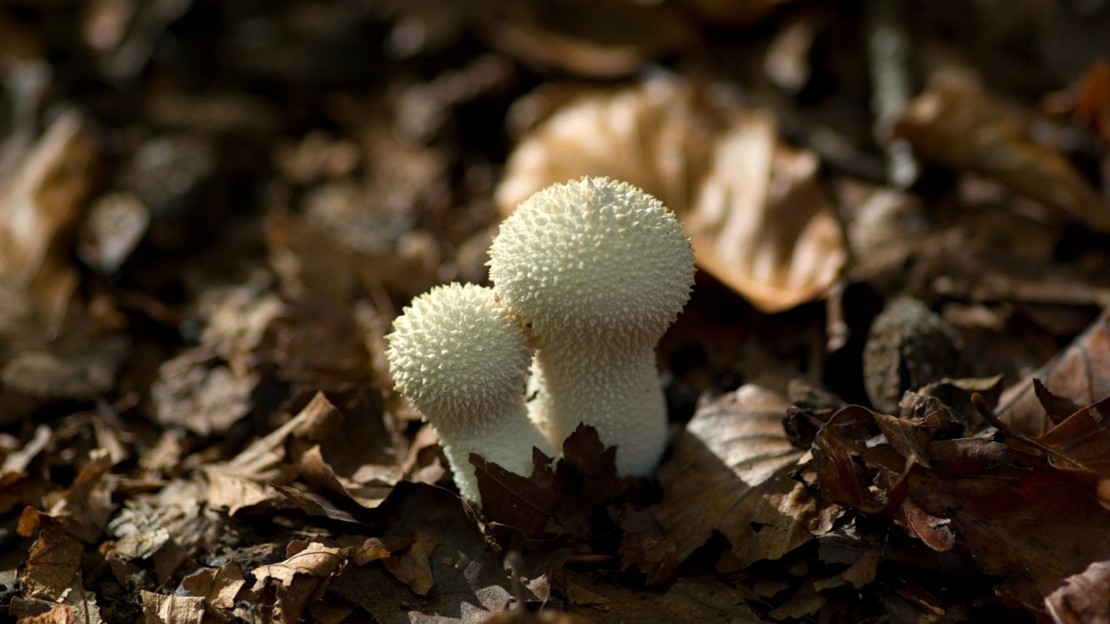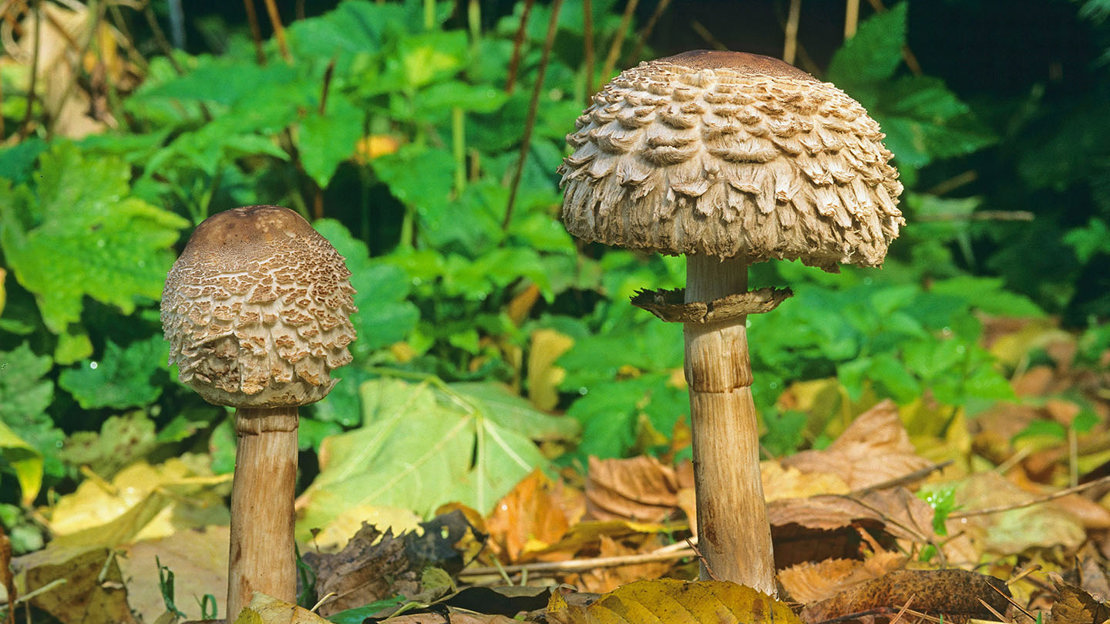For hundreds of years, fungi were classed as plants. In fact, they’re a kingdom all their own and are more closely related to humans than plants.
Types of mushroom in the UK: common identification guide

Digital Content Manager
From fairy toadstools to wobbly blobs of jelly, fungi are a huge and fascinating kingdom with around 15,000 species in the UK.
The mushroom (or toadstool) is the fleshy fruiting body you see above the earth. The bulk of the fungus actually lives underground – an intricate network of strands called hyphae, which are collectively known as the mycelium and can stretch for miles, gathering nutrients for the fungus.
If you’re trying to learn how to identify UK mushrooms, our guide to 13 common species is a great place to start.
Please be aware that some fungi can be deadly poisonous – don’t use this blog to identify them for culinary use.

1. Amethyst deceiver (Laccaria amethystina)
This pretty purple fungus is a very common autumn mushroom in the UK, usually seen brightening up the woodland floor between September and December.
How to identify it
Amethyst deceivers are much smaller than expected – ranging in size from around 2cm–7cm – but once you’ve got your eye in, you can’t miss their distinctive colour. These mushrooms are deep purple when young, then fade to lilac and sometimes even white. The gills are the same colour as the cap of the mushroom and are widely spaced. The stem is tough, fibrous and often twisted.
Where to find it
This woodland mushroom is mostly found growing amongst the leaf litter beneath beech trees, often in large crowds. It also grows around silver birch and oak.

2. Collared earthstar (Geastrum triplex)
This is the largest species of earthstar mushroom in the UK and the one you’re most likely to see.
How to identify it
The collared earthstar looks at first like a small onion. As it matures, the outer skin cracks and peels back into 5-8 pointed rays, revealing a spore sac in the middle. The rays bend back and curl underneath the mushroom, raising up the spore sac, which has a small opening at the top for spores to escape.
Where to find it
Beneath deciduous trees on nutrient-rich soil. It seems to prefer growing on slopes rather than flat ground and tends to fruit after rain, between July and November.

3. Yellow brain fungus (Tremella mesenterica)
Yellow brain is a parasitic fungus that doesn’t feed on dead wood itself – it eats the mycelium of the fungi that do. Its nickname, witch’s butter, comes from a European legend that if yellow brain fungus appeared on the gate or door of a house, it meant that a witch had cast a spell on the family living there. You can spot it all year round, but it’s most visible in autumn and winter.
How to identify it
Yellow brain fungus can range in colour from golden yellow to bright orange. It grows in gelatinous lobes and folds.
Where to find it
It can be found on various deciduous trees where its host species (usually oak crust, rosy crust or Peniophora cinerea fungi) grow. It can shrivel up and become unrecognisable in dry weather, so the best time to look for it is after rain, when it’s at its slimy, wobbly best.
Identify fungi on the go
Discover fungi when you're out and about with your own pocket-sized identification guide to the UK's common species.
Buy it now
4. Common earthball (Scleroderma citrinum)
Unlike puffballs, which have a central opening in the top to ‘puff’ their spores, the common earthball’s scaly cap splits open to release spores. It tends to appear from July to November.
How to identify it
The common earthball is round, a dirty yellow to ochre-brown colour and can measure up to 10cm across. The thick, tough skin is covered in warty scales. It might not sound like much to look at, but this mushroom's beauty is hidden on the inside. Cut a mature one in half to see a mass of purple-black, powdery spores sometimes threaded with white veins.
Where to find it
On mossy or peaty soil on heaths or in rich woodland.

5. Common inkcap (Coprinopsis atramentaria)
This little mushroom packs some serious muscle – the common inkcap has been known to push its way through asphalt and even lift the corners of paving stones. It has a long season and can be spotted from spring to late autumn.
How to identify it
It has a fawn-grey, conical cap that’s grooved and often split at the edges. The stem is white and hollow, and the crowded gills turn white to grey then eventually black, at which point they break down and melt into an inky liquid.
Where to find it
This is a very common mushroom in the UK and can be found anywhere there is buried wood, which it grows from in clusters. Keep your eyes peeled beside footpaths and at the base of trees in parks, gardens and woods.

6. Fly agaric (Amanita muscaria)
Traditionally used as an insecticide, fly agaric contains ibotenic acid, which both attracts and kills flies. This mushroom can grow very large – up to 20cm in diameter!
How to identify it
Probably our most familiar toadstool, it has a brilliant scarlet or orange cap covered with white, wart-like spots – the remains of the sac it emerges from. The gills and stem are both white, and the stem has a floppy skirt near the cap.
Where to find it
Fly agaric has a symbiotic relationship with the trees around it, particularly birch. It also grows alongside conifer species such as pine and spruce, appearing in both mixed woodland and heathland from late summer to autumn.

7. Candlesnuff fungus (Xylaria hypoxylon)
Candlesnuff is a weird and wonderful fungus that looks more like antlers or a crowd of little ghosts growing out of dead wood. It can be seen throughout the year.
How to identify it
This mushroom gets its common name from the fact that it looks like a snuffed-out candle wick – black on the lower half, with a dusting of greyish-white above. This powdery coating contains the fungus’ spores.
Where to find it
Candlesnuff fungus grows on the dead and rotting wood of a range of deciduous trees, from stumps to fallen branches. You can find it everywhere from woodlands to urban parks.

8. Common puffball (Lycoperdon perlatum)
This species is also known as the devil's snuff-box, or wolf's fart! The name Lycoperdon literally means 'wolf's flatulence'.
How to identify it
The common puffball grows in an upturned pear shape, usually 3–6cm across and 4–9cm tall. It has tiny, pearl-like spines covering the outer surface and starts life pure white, before turning yellow or brown with age. As the mushroom matures, the spines fall off to reveal a beautiful lace-like texture.
Where to find it
Growing in groups from the leaf litter in all kinds of woodland from July to November. It has even been known to sprout in grassland and pasture, though much less often.

9. Jelly ear (Auricularia auricula-judae)
This distinctive mushroom is named after the apostle, Judas, who is said to have hung himself from an elder tree. It can can be seen all year round.
How to identify it
Jelly ears are cup-shaped, at first, before developing into lobes that make them look uncannily like human ears. They're a lovely chestnut-brown colour and feel velvety on the outside, with a wrinkled inner surface.
Where to find it
Growing in clusters from dead and dying branches, mainly of elder, but sometimes other trees.

10. Scarlet elf cup (Sarcoscypha austriaca)
One of the brightest and most interesting mushrooms in the UK. Folklore tells that woodland elves drank and bathed in the water which collected in the cups of the fungus.
Scarlet elf cup makes a tiny puffing sound when it shoots spores into the air.
How to identify it
Cup shaped, with a peachy-orange outer skin and scarlet red centre. The cups are usually around 2–7cm in diameter and are attached by a little stalk. It can easily be confused with the ruby elf cup mushroom, which looks identical and can only be distinguished by looking for tiny hairs under a microscope.
Where to find it
On decaying sticks and branches buried in leaf litter or moss in damp places on the woodland floor. They're more common in areas of high rainfall and can be seen in the colder months, from around December to April.

11. Stinkhorn (Phallus impudicus)
You'll often smell a stinkhorn before you spot one. Its foul odour of rotting flesh attracts flies and other insects which land on the sticky, spore-laden tip and help the mushroom reproduce.
How to identify it
It first appears like a round white ball nestling in leaf litter. Known as a stinkhorn egg, this eventually splits so the thick, white, polystyrene-like stem can emerge. The conical cap is covered in olive-green slime which is eventually devoured by flies, revealing a white honeycomb pattern that looks far too pretty for such a phallic mushroom!
Where to find it
The stinkhorn can be found in all kinds of woodland. Search (or follow your nose!) around areas of dead and rotting wood from June to November.

12. Turkeytail (Trametes versicolor)
This bracket fungus is very common in the UK and can be found throughout the year. It was formerly known as the many-zoned polypore.
How to identify it
Turkeytail mushrooms can reach up to 10cm in diameter and grow in tiered, fan-shaped groups which look a little like turkey feathers. The flesh is smooth, leathery and decorated with beautiful, multi-coloured bands ranging from shades of blue, purple and green to brown, black and cream. On the underside, these mushrooms have pores rather than gills.
Where to find it
These bracket fungi grow on the dead wood of broadleaved trees – look for them on logs, stumps, fallen branches and standing dead trees.

13. Shaggy parasol (Chlorophyllum rhacodes)
Its scientific name rhacodes comes from the Greek word rhakos, which means a piece of cloth. It does often have a soft, ragged, fabric-like appearance.
How to identify it
The cap goes from egg-shaped to flat, with shaggy brown scales on a cream background. The gills are creamy-white and bruise red when damaged. The stem is bulbous at the base and has a floppy ring that can be moved up and down.
Where to find it
Shaggy parasol will grow in troops or rings in any shady woodland, but particularly with conifers. Look out for it from summer to late autumn.






